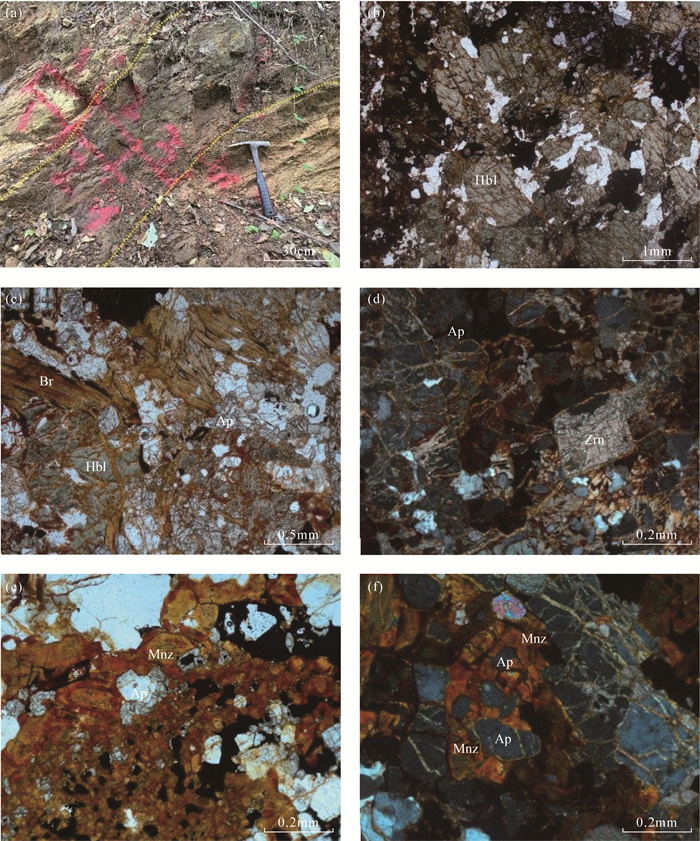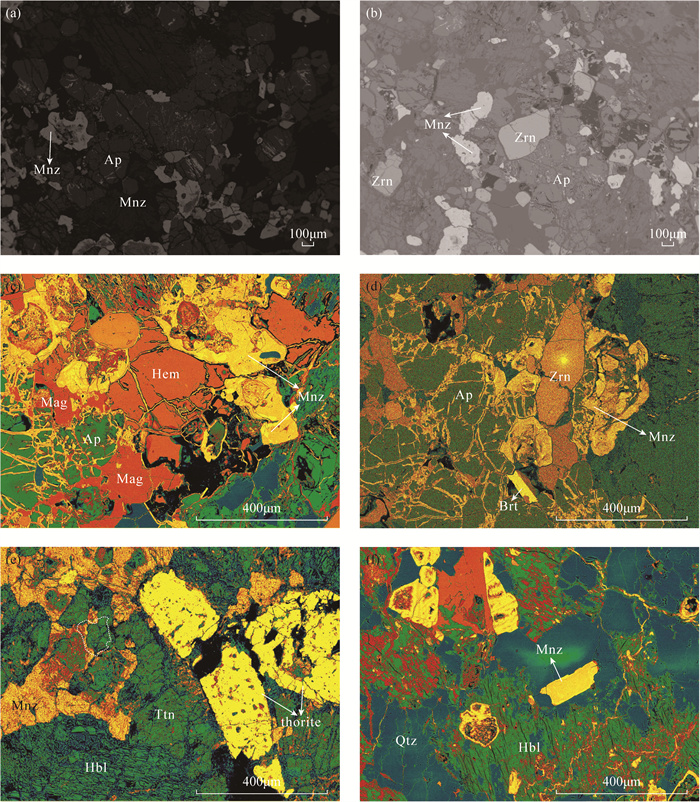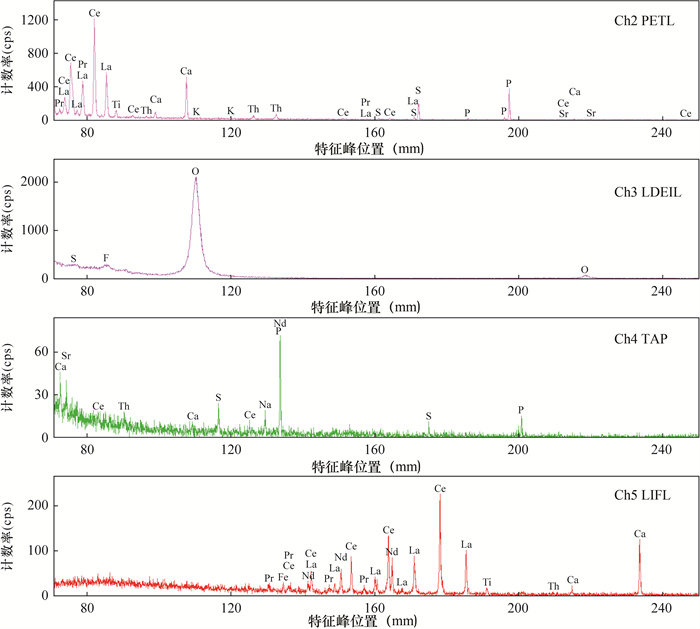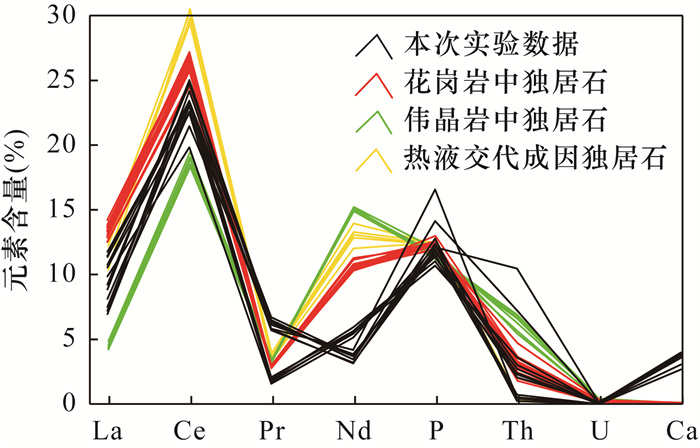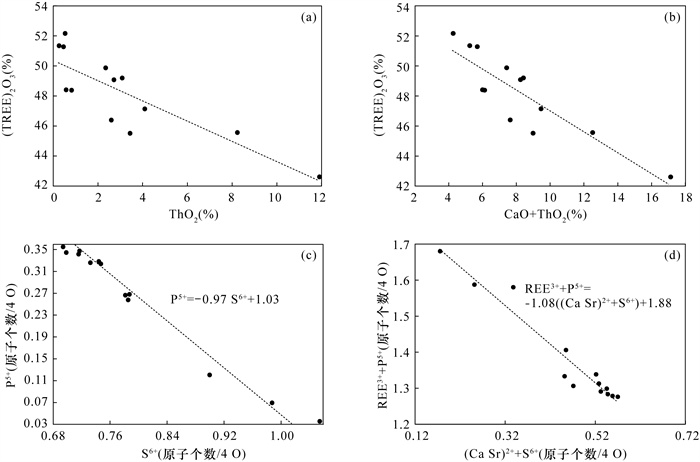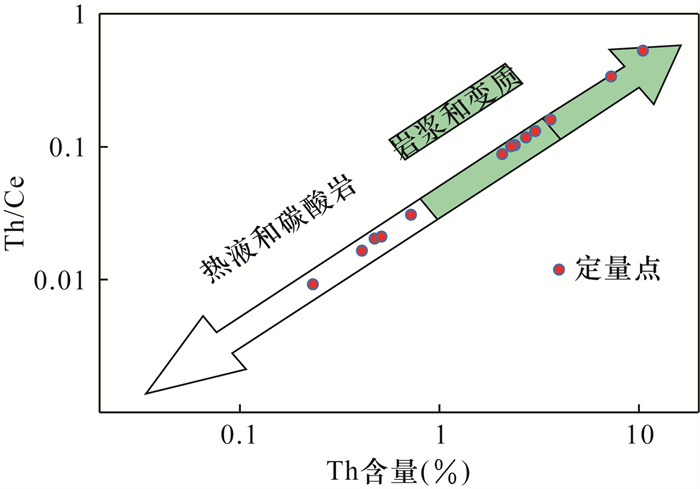Study on Geochemical Characteristics and REE Mineralization of S-enriched Monazite in the Dabie Orogenic Belt by Electron Probe Microanalysis
-
摘要:
独居石是常见的赋稀土矿物,也是许多稀土矿床中重要的矿石矿物,而含硫独居石却相对罕见,只在为数不多的一些碳酸岩、金伯利岩、变质岩中被发现。本文在大别造山带蕲春县白羊沟地区发现的富稀土矿样品中,利用偏光显微镜镜下鉴定、电子探针定性和定量分析相结合的技术手段测定富硫独居石中的硫、稀土元素等主要化学成分的含量,研究其地球化学特征以及成因。结果表明:研究区稀土矿化角闪片岩中的富硫独居石大多呈胶状、团块状,部分呈现板状、柱状自形晶体,且呈粒状集合体状,和磷灰石之间存在相互交生、包含、半包含的空间关系,或呈网脉状交代切割磷灰石,岩相学表明富硫独居石与磷灰石之间存在着类似热液蚀变的交代关系。富稀土矿样品中富硫独居石SO3含量最高达14.57%,平均含量为10.54%,是目前国内外已知的硫含量最高的独居石,同时测得富硫独居石CaO含量较高,NdO含量偏低,与花岗岩成因的独居石和热液交代的不含硫独居石成分差异较大,地球化学显示S6+与P5+呈负相关性以及(Sr, Ca)2+、S6+与REE3+、P5+呈负相关性,并可以用“硬石膏耦合”置换反应来解释其独居石含S的原因,即(Sr, Ca)2++S6+↔REE3++P5+,也就意味着白羊沟地区存在着与稀土矿化相关的热液活动,结合白羊沟地区的地质背景推断其热液来源可能与白垩世以来该地区经历了强烈的岩石圈伸展运动和岩浆活动晚期热液有关。研究结果为白羊沟地区的稀土多金属矿化成因研究提供了新线索。
Abstract:BACKGROUND Monazite is a common rare earth mineral and an important ore mineral in many rare earth deposits, while sulfur-containing monazite is relatively rare and is only found in a few carbonate rocks, kimberlites, and metamorphic rocks.
OBJECTIVES To accurately analyze the chemical composition of S-enriched monazite, and to infer its genesis.
METHODS The main chemical components of S-enriched monazite from the REE ores in the Baiyanggou area of Puchun County, Dabie orogenic belt were determined by polarized light microscopy and electron probe microanalysis.
RESULTS The sulfur-enriched monazite in the rare-earth mineralized amphibole schist in the study area was mostly colloidal and agglomerate, some were plate-like and columnar euhedral crystals, which were granular aggregates. There was mutual interaction, inclusion, and a semi-inclusion spatial relationship between sulfur-enriched monazite and apatite. Crosscut of apatite by network veins was also present. Petrography showed that there was a metasomatism similar to hydrothermal alteration between sulfur-enriched monazite and apatite. The SO3 content of S-enriched monazite in the rare earth-enriched mineral samples was as high as 14.57%, with an average content of 10.54%, which was the monazite with the highest S content. The S-enriched monazite has a higher CaO content and a low NdO content, which was quite different from the composition of the granite genesis monazite and hydrothermal metasomatic sulfur-deficient monazite. According to the negative correlation between S6+ and P5+, as well as the negative correlation between (Sr, Ca)2+, S6+ and REE3+, P5+, the S-containing monazatite can be explained by the "anhydrite coupling" displacement reaction, that is, (Sr, Ca)2++S6+↔REE3++P5+. This indicated that hydrothermal activity related to REE mineralization in the Baiyanggou area was present.
CONCLUSIONS Combined with the geological background of the Baiyanggou area, it is inferred that the source of the hydrothermal fluid may be related to the intense lithospheric extensional movement and the late magmatic activity in the study area since the Cretaceous period. This provides new clues for research on the origin of rare earth polymetallic mineralization in this area.
-

-
图 5 白羊沟地区富硫独居石与不同成因独居石的成分分布特征(对比数据来源于洪文兴等[5])
Figure 5.
图 7 白羊沟地区富硫独居石成因的地球化学判别图[35]
Figure 7.
表 1 白羊沟地区富硫独居石EPMA定量点分析数据
Table 1. Analysis data of EPMA quantitative points of S-enriched monazite in the Baiyanggou area
元素 富硫独居石中各成分含量(%) P2O5 18.99 20.15 20.20 19.57 21.49 21.85 29.41 21.99 20.90 22.69 20.50 21.18 25.07 SO3 13.64 13.06 14.04 14.57 10.27 10.83 1.44 10.91 13.20 4.42 14.46 13.60 2.57 CaO 5.36 5.08 5.33 5.53 5.22 4.98 3.72 5.04 5.56 5.22 5.42 5.30 4.27 TiO2 ND 0.85 ND ND ND 0.15 0.10 2.06 0.32 0.37 ND ND 0.02 ThO2 4.10 2.35 3.08 2.72 11.91 0.26 0.54 2.60 3.44 0.47 0.58 0.82 8.24 UO2 ND 0.18 ND ND 0.12 ND ND 0.02 0.12 ND ND ND 0.05 F 0.42 ND 0.45 0.58 0.61 0.80 1.37 0.78 0.43 0.92 0.96 0.78 0.74 Al2O3 0.20 0.11 0.12 0.13 0.16 0.16 0.38 0.15 0.13 0.12 0.09 0.05 0.27 SrO 1.04 0.75 0.99 1.20 1.35 0.58 0.50 0.52 0.72 0.69 0.78 0.92 0.83 SiO2 0.27 0.01 0.15 0.08 0.18 0.14 0.04 0.09 0.24 0.14 0.08 0.13 0.04 La2O3 12.36 13.44 13.80 12.61 11.56 10.38 13.33 9.53 8.15 10.82 8.44 8.78 8.81 Ce2O3 26.31 27.43 26.96 27.30 23.23 29.30 27.16 26.46 26.97 28.96 28.31 27.41 25.14 Pr2O3 1.99 2.43 2.13 2.26 1.84 7.36 6.82 6.76 6.67 7.49 7.17 7.84 7.60 Nd2O3 6.48 6.58 6.32 6.91 5.98 4.30 4.86 3.66 3.74 4.02 4.49 4.35 4.01 Total 91.15 92.41 93.57 93.47 93.92 91.10 89.65 90.57 90.58 86.32 91.28 91.16 87.66 P 10.70 11.36 11.38 11.03 12.11 12.31 16.57 12.39 11.78 12.78 11.55 11.93 14.13 S 5.46 5.23 5.62 5.83 4.11 4.34 0.58 4.37 5.28 1.77 5.79 5.45 1.03 Ca 3.83 3.63 3.81 3.95 3.73 3.56 2.66 3.60 3.97 3.73 3.87 3.79 3.05 Ti ND 0.51 ND ND ND 0.09 0.06 1.23 0.19 0.22 ND ND 0.01 Th 3.60 2.06 2.71 2.39 10.47 0.23 0.47 2.28 3.02 0.41 0.51 0.72 7.24 U ND 0.16 ND ND 0.11 ND ND 0.02 0.10 ND ND ND 0.04 F 0.42 ND 0.45 0.58 0.61 0.80 1.37 0.78 0.43 0.92 0.96 0.78 0.74 Al 0.11 0.06 0.06 0.07 0.08 0.09 0.20 0.08 0.07 0.06 0.05 0.02 0.14 Sr 0.88 0.64 0.84 1.01 1.14 0.49 0.42 0.44 0.61 0.58 0.66 0.78 0.70 Si 0.13 ND 0.07 0.04 0.08 0.07 0.02 0.04 0.11 0.06 0.04 0.06 0.02 La 10.54 11.46 11.76 10.75 9.86 8.85 11.37 8.12 6.95 9.23 7.20 7.49 7.51 Ce 22.46 23.42 23.01 23.31 19.83 25.02 23.18 22.59 23.02 24.72 24.17 23.41 21.47 Pr 1.70 2.07 1.82 1.93 1.57 6.29 5.82 5.78 5.70 6.40 6.13 6.69 6.49 Nd 5.56 5.64 5.42 5.92 5.13 3.69 4.17 3.13 3.20 3.44 3.85 3.73 3.44 P 10.70 11.36 11.38 11.03 12.11 12.31 16.57 12.39 11.78 12.78 11.55 11.93 14.13 La/Nd 1.90 2.03 2.17 1.82 1.92 2.40 2.73 2.59 2.17 2.68 1.87 2.01 2.18 注:ND表示低于检测限,未检出。 -
[1] Williams M L, Jercinovic M J, Hetherington C J. Microprobe monazite geochronology: Understanding geologic processes by integrating composition and chronology[J]. Annual Review of Earth & Planetary Sciences, 2007, 35: 137-175.
[2] Chakhmouradian A R, Wall F. Rare earth elements: Min-erals, mines, magnets (and more)[J]. Elements, 2012, 8(5): 333-340. doi: 10.2113/gselements.8.5.333
[3] 梁晓, 徐亚军, 訾建威, 等. 独居石成因矿物学特征及其对U-Th-Pb年龄解释的制约[J]. 地球科学, 2022, 47(4): 1383-1398. https://www.cnki.com.cn/Article/CJFDTOTAL-DQKX202204014.htm
Liang X, Xu Y J, Zi J W, et al. Genetic mineralogy of monazite and constraints on the interpretation of U-Th-Pb ages[J]. Earth Science, 2022, 47(4): 1383-1398. https://www.cnki.com.cn/Article/CJFDTOTAL-DQKX202204014.htm
[4] Verplanck P L. The role of fluids in the formation of rare earth element deposits[J]. Procedia Earth and Planetary Science, 2017, 17: 758-761. doi: 10.1016/j.proeps.2017.01.014
[5] 洪文兴, 朱祥坤. 独居石微粒微区成分分布的研究[J]. 高校地质学报, 2000, 6(2): 167-172. doi: 10.3969/j.issn.1006-7493.2000.02.009
Hong W X, Zhu X K. A microanalysis study on monazite composition distribution[J]. Geological Journal of China Universities, 2000, 6(2): 167-172. doi: 10.3969/j.issn.1006-7493.2000.02.009
[6] 邱昆峰, 杨立强. 独居石成因特征与U-Th-Pb定年及三江特提斯构造演化研究例析[J]. 岩石学报, 2011, 27(9): 2721-2732. https://www.cnki.com.cn/Article/CJFDTOTAL-YSXB201109021.htm
Qiu K F, Yang L Q. Genetic feature of monazite and its U-Th-Pb dating: Critical considerations on the tectonic evolution of Sanjiang Tethys[J]. Acta Petrologica Sinica, 2011, 27(9): 2721-2732. https://www.cnki.com.cn/Article/CJFDTOTAL-YSXB201109021.htm
[7] Engi M. Petrochronology based on REE-minerals: Monazite, allanite, xenotime, apatite[J]. Reviews in Mineralogy and Geochemistry, 2017, 83(1): 365-418. doi: 10.2138/rmg.2017.83.12
[8] 吴黎光, 李献华. 独居石微区同位素和元素分析及地质应用[J]. 矿物岩石地球化学通报, 2020, 39(6): 18. https://www.cnki.com.cn/Article/CJFDTOTAL-KYDH202006003.htm
Wu L G, Li X H. Isotopic and elemental microanalyses of monazite and its geological application[J]. Bulletin of Mineralogy Petrology and Geochemistry, 2020, 39(6): 18. https://www.cnki.com.cn/Article/CJFDTOTAL-KYDH202006003.htm
[9] 王濮, 潘兆橹, 翁玲宝, 等. 系统矿物学[M]. 北京: 地质出版社, 1987.
Wang P, Pan Z L, Weng L B, et al. Systematic mineralogy[M]. Beijing: Geological Publishing House, 1987.
[10] Krenn E, Putz H, Finger F, et al. Sulfur-rich monazite with high common Pb in ore-bearing schists from the Schellgaden mining district (Tauern Window, eastern Alps)[J]. Mineralogy and Petrology, 2011, 102(1-4): 51-62. doi: 10.1007/s00710-011-0170-x
[11] Enkhbayar D, Seo J, Choi S G, et al. Mineral chemistry of REE-rich apatite and sulfur-rich monazite from the Mushgai Khudag, alkaline volcanic-plutonic complex, South Mongolia[J]. International Journal of Geosciences, 2016, 7(1): 20-31. doi: 10.4236/ijg.2016.71003
[12] Prokopyev I R, Doroshkevich A G, Ponomarchuk A V, et al. Mineralogy, age and genesis of apatite-dolomite ores at the Seligdar apatite deposit (central Aldan, Russia)[J]. Ore Geology Reviews, 2017, 81: 296-308. doi: 10.1016/j.oregeorev.2016.10.012
[13] Chakhmouradian A R, Mitchell R H. Niobian ilmenite, hydroxylapatite and sulfatian monazite: Alternative hosts for incompatible elements in calcite kimberlite from Internatsional'naya, Yakutia[J]. Canadian Mineralogist, 1999, 37: 1177-1189.
[14] Suzuki K, Kato T. CHIME dating of monazite, xenotime, zircon and polycrase: Protocol, pitfalls and chemical criterion of possibly discordant age data[J]. Gondwana Research, 2008, 14(4): 569-586. doi: 10.1016/j.gr.2008.01.005
[15] Prsek J, Ondrejka M, Baík P, et al. Metamorphic-hydrothermal REE minerals in the Bacúch magnetite deposit, western Carpathians, Slovakia: (Sr, S)-rich monazite-(Ce) and Nd-dominant hingganite[J]. The Canadian Mineralogist, 2010, 48(1): 81-94. doi: 10.3749/canmin.48.1.81
[16] Ondrejka M, Putiš M, Uher P, et al. Fluid-driven destab-ilization of REE-bearing accessory minerals in the granitic orthogneisses of North Veporic basement (western Carpathians, Slovakia)[J]. Mineralogy and Petrology, 2016, 110(5): 561-580. doi: 10.1007/s00710-016-0432-8
[17] Laurent A T, Seydoux-Guillaume A M, Duchene S, et al. Sulphate incorporation in monazite lattice and dating the cycle of sulphur in metamorphic belts[J]. Contributions to Mineralogy and Petrology, 2016, 171(11): 94. doi: 10.1007/s00410-016-1301-5
[18] Chen W, Honghui H, Bai T, et al. Geochemistry of monazite within carbonatite related REE deposits[J]. Resources, 2017, 6(4): 51. doi: 10.3390/resources6040051
[19] 张国伟, 孟庆任, 于在平, 等. 秦岭造山带的造山过程及其动力学特征[J]. 中国科学: 地球科学, 1996, 26(3): 193-200. https://www.cnki.com.cn/Article/CJFDTOTAL-JDXK199603000.htm
Zhang G W, Meng Q R, Yu Z P, et al. Orogenic process and dynamic characteristics of Qinling orogenic belt[J]. Science in China: Earth Sciences, 1996, 26(3): 193-200. https://www.cnki.com.cn/Article/CJFDTOTAL-JDXK199603000.htm
[20] 许长海. 大别造山带碰撞后构造热/岩浆演化过程[D]. 上海: 同济大学, 2002.
Xu C H. Tectonic thermal/magmatic evolution after collision in the Dabieshan Orogen[D]. Shanghai: Tongji University, 2002.
[21] 张国伟, 董云鹏, 赖绍聪, 等. 秦岭—大别造山带南缘勉略构造带与勉略缝合带[J]. 中国科学: 地球科学, 2003, 33(12): 1121-1135. https://www.cnki.com.cn/Article/CJFDTOTAL-JDXK200312000.htm
Zhang G W, Dong Y P, Lai S C, et al. The Mianlue structural belt and the Mianlue suture in the southern margin of the Qinling—Dabie orogenic belt[J]. Science in China: Earth Sciences, 2003, 33(12): 1121-1135. https://www.cnki.com.cn/Article/CJFDTOTAL-JDXK200312000.htm
[22] Wu Y B, Zheng Y F. Tectonic evolution of a composite collision orogen: An overview on the Qinling—Tongbai—Hong'an—Dabie—Sulu orogenic belt in central China[J]. Gondwana Research, 2013, 23(4): 1402-1428. doi: 10.1016/j.gr.2012.09.007
[23] 刘晓春, 李三忠, 江博明. 桐柏—红安造山带的构造演化: 从大洋俯冲/增生到陆陆碰撞[J]. 中国科学: 地球科学, 2015, 45(8): 1088-1108. https://www.cnki.com.cn/Article/CJFDTOTAL-JDXK201508002.htm
Liu X C, Li S Z, Jiang B M. Tectonic evolution of the Tongbai—Hong'an orogen in central China: From oceanic subduction/accretion to continent-continent collision[J]. Science in China: Earth Sciences, 2015, 45(8): 1088-1108. https://www.cnki.com.cn/Article/CJFDTOTAL-JDXK201508002.htm
[24] 李锦铁. 中朝地块与扬子地块碰撞的时限与方式——长江中下游地区震旦纪—侏罗纪沉积环境的演变[J]. 地质学报, 2001, 75(1): 25-34. doi: 10.3321/j.issn:0001-5717.2001.01.003
Li J T. Pattern and time of the collision between the Sino—Korean and Yangtze blocks: Evolution of the Sinian—Jurassic sedimentary settings in the middle-lower reaches of the Yangtze River[J]. Acta Geologica Sinica, 2001, 75(1): 25-34. doi: 10.3321/j.issn:0001-5717.2001.01.003
[25] 许长海, 周祖翼, 马昌前, 等. 大别造山带140~85Ma热窿伸展作用——年代学约束[J]. 中国科学: 地球科学, 2001, 31(11): 925-936. https://www.cnki.com.cn/Article/CJFDTOTAL-JDXK200111006.htm
Xu C H, Zhou Z Y, Ma C Q, et al. Thermal extension of the Dabie orogenic belt from 140 to 85Ma—Chronological constraints[J]. Science in China: Earth Sciences, 2001, 31(11): 925-936. https://www.cnki.com.cn/Article/CJFDTOTAL-JDXK200111006.htm
[26] 张超, 马昌前. 大别山晚中生代巨量岩浆活动的启动: 花岗岩锆石U-Pb年龄和Hf同位素制约[J]. 矿物岩石, 2008, 28(4): 71-79. doi: 10.3969/j.issn.1001-6872.2008.04.013
Zhang C, Ma C Q. Large-scale late mesozoic magmatism in the Dabie mountain: Constraints from zircon U-Pb dating and Hf isotopes[J]. Mineralogy and Petrology, 2008, 28(4): 71-79. doi: 10.3969/j.issn.1001-6872.2008.04.013
[27] 刘玉龙, 陈江峰, 李惠民, 等. 白云鄂博矿床白云石型矿石中独居石单颗粒U-Th-Pb-Sm-Nd定年[J]. 岩石学报, 2005, 21(3): 881-888. https://www.cnki.com.cn/Article/CJFDTOTAL-YSXB200503028.htm
Liu Y L, Chen J F, Li H M, et al. Single-grain U-Th-Pb-Sm-Nd dating of monazite from dolomite type ore of the Bayan Obo deposit[J]. Acta Petrologica Sinica, 2005, 21(3): 881-888. https://www.cnki.com.cn/Article/CJFDTOTAL-YSXB200503028.htm
[28] 陈益平, 潘家永, 胡凯, 等. 贵州遵义镍-钼富集层中独居石的发现及成因意义[J]. 岩石矿物学杂志, 2007, 26(4): 340-344. doi: 10.3969/j.issn.1000-6524.2007.04.007
Chen Y P, Pan J Y, Hu K, et al. Discovery of monazite in the Ni-Mo sulfide layer of Zunyi, Guizhou Province, and its genetic significance[J]. Acta Petrological et Mineralogica, 2007, 26(4): 340-344. doi: 10.3969/j.issn.1000-6524.2007.04.007
[29] Al Ani T, Sarapää O. Geochemistry and mineral phases of REE in Jammi carbonatite veins and fenites, southern end of the Sokli complex, NE Finland[J]. Geochemistry: Exploration, Environment, Analysis, 2013, 13(3): 217-224. doi: 10.1144/geochem2011-088
[30] 张龙, 陈振宇, 汪方跃, 等. 电子探针技术研究粤北龙华山岩体中独居石蚀变晕圈的结构与成分特征[J]. 岩矿测试, 2022, 41(2): 174-184. http://www.ykcs.ac.cn/cn/article/doi/10.15898/j.cnki.11-2131/td.202109070118
Zhang L, Chen Z Y, Wang F Y, et al. Application of electron microprobe to textural and compositional characteristics of alteration coronas of monazite from the Longhuashan granite, northern Guangdong Province[J]. Rock and Mineral Analysis, 2022, 41(2): 174-184. http://www.ykcs.ac.cn/cn/article/doi/10.15898/j.cnki.11-2131/td.202109070118
[31] 汪双双, 吴春俊, 李艳广, 等. 西秦岭阳山金矿带花岗斑岩中独居石的矿物学特征及成因指示[J]. 矿物岩石地球化学通报, 2018, 37(3): 529-538. https://www.cnki.com.cn/Article/CJFDTOTAL-KYDH201803015.htm
Wang S S, Wu C J, Li Y G, et al. Mineralogical characteristics and their genetic implication of monazite in granite porphyries from the Yangshan gold metallogenic belt, West Qinling mountains[J]. Bulletin of Mineralogy, Petrology and Geochemistry, 2018, 37(3): 529-538. https://www.cnki.com.cn/Article/CJFDTOTAL-KYDH201803015.htm
[32] 王芳, 朱丹, 鲁力, 等. 应用电子探针分析技术研究某铌-稀土矿中铌和稀土元素的赋存状态[J]. 岩矿测试, 2021, 40(5): 670-679. http://www.ykcs.ac.cn/cn/article/doi/10.15898/j.cnki.11-2131/td.202006090086
Wang F, Zhu D, Lu L, et al. Occurrence of niobium and rare earth elements in related ores by electron microprobe[J]. Rock and Mineral Analysis, 2021, 40(5): 670-679. http://www.ykcs.ac.cn/cn/article/doi/10.15898/j.cnki.11-2131/td.202006090086
[33] 万建军, 潘春蓉, 严杰, 等. 应用电子探针-扫描电镜研究陕西华阳川铀稀有多金属矿床稀土矿物特征[J]. 岩矿测试, 2021, 40(1): 145-155. http://www.ykcs.ac.cn/cn/article/doi/10.15898/j.cnki.11-2131/td.202005060009
Wan J J, Pan C R, Yan J, et al. EMPA-SEM study on the rare earth minerals from the Huayangchuan uraniumare polymetallic deposit, Shaanxi Province[J]. Rock and Mineral Analysis, 2021, 40(1): 145-155. http://www.ykcs.ac.cn/cn/article/doi/10.15898/j.cnki.11-2131/td.202005060009
[34] Broom-Fendley S, Smith M P, Andrade M B, et al. Sulfur-bearing monazite-(Ce) from the Eureka carbonatite, Namibia: Oxidation state, substitution mechanism, and formation conditions[J]. Mineralogical Magazine, 2019, 84(1): 35-48.
[35] Wu L G, Li X H, Ling X X, et al. Further characterization of the RW-1 monazite: A new working reference material for oxygen and neodymium isotopic microanalysis[J]. Minerals, 2019, 9(10): 583. doi: 10.3390/min9100583
[36] Kukharenko A A, Orlova M P, Bulakh A G, et al. The Caledonian Complex of ultrabasic alkaline rocks and carbonatites of the Kola Peninsula and northern Karelia[R]. Russia: Nedra Press Leningrad, 1965.
[37] Nikolenko A M, Redina A A, Doroshkevich A G, et al. The origin of magnetite-apatite rocks of Mushgai—Khudag Complex, South Mongolia: Mineral chemistry and studies of melt and fluid inclusions[J]. Lithos, 2018, 320: 567-582.
[38] Okay A I, Xu S, Sengor A M C. Coesite from the Dabie Shan eclogites, central China[J]. European Journal of Mineralogy, 1989, 1(4): 595-598. doi: 10.1127/ejm/1/4/0595
[39] Jahn B, Wu F, Lo C H, et al. Crust-mantle interaction induced by deep subduction of the continental crust: Geochemical and Sr-Nd isotopic evidence from post-collisional mafic-ultramafic intrusions of the northern Dabie complex, central China[J]. Chemical Geology, 1999, 157(1): 119-146.
[40] 马昌前, 杨坤光, 明厚利, 等. 大别山中生代地壳从挤压转向伸展的时间: 花岗岩的证据[J]. 中国科学: 地球科学, 2003, 33(9): 817-827. https://www.cnki.com.cn/Article/CJFDTOTAL-JDXK200309000.htm
Ma C Q, Yang K G, Ming H L, et al. The time when the Mesozoic crust in the Dabie Mountains changed from compression to extension: Evidence for granites[J]. Science in China: Earth Sciences, 2003, 33(9): 817-827. https://www.cnki.com.cn/Article/CJFDTOTAL-JDXK200309000.htm
[41] 杨谦, 施炜, 侯贵廷. 中国东部及邻区晚中生代伸展拆离构造——综述与新认识[J]. 地球学报, 2019, 40(4): 511-544. https://www.cnki.com.cn/Article/CJFDTOTAL-DQXB201904002.htm
Yang Q, Shi W, Hou G T. Late mesozoic extensional detachment structures in eastern China and adjacent areas: Overview and new insight[J]. Acta Geoscientica Sinica, 2019, 40(4): 511-544. https://www.cnki.com.cn/Article/CJFDTOTAL-DQXB201904002.htm
[42] 李石, 王彤. 桐柏山—大别山花岗岩类地球化学[M]. 武汉: 中国地质大学出版社, 1991.
Li S, Wang T. Geochemistry of granitoids in Tongbaishan—Dabieshan, central China[M]. Wuhan: China University of Geosciences Press, 1991.
[43] 龚银杰, 朱江, 陈冬明, 等. 大别山南麓梨木岭钼矿床辉钼矿Re-Os同位素年龄及地质意义[J]. 矿床地质, 2017, 36(4): 992-1002. https://www.cnki.com.cn/Article/CJFDTOTAL-KCDZ201704013.htm
Gong Y J, Zhu J, Chen D M, et al. Re-Os isotopic ages of Limuling molybdenum deposit in southern Dabie Mountain and their geological significance[J]. Mineral Deposits, 2017, 36(4): 992-1002. https://www.cnki.com.cn/Article/CJFDTOTAL-KCDZ201704013.htm
-



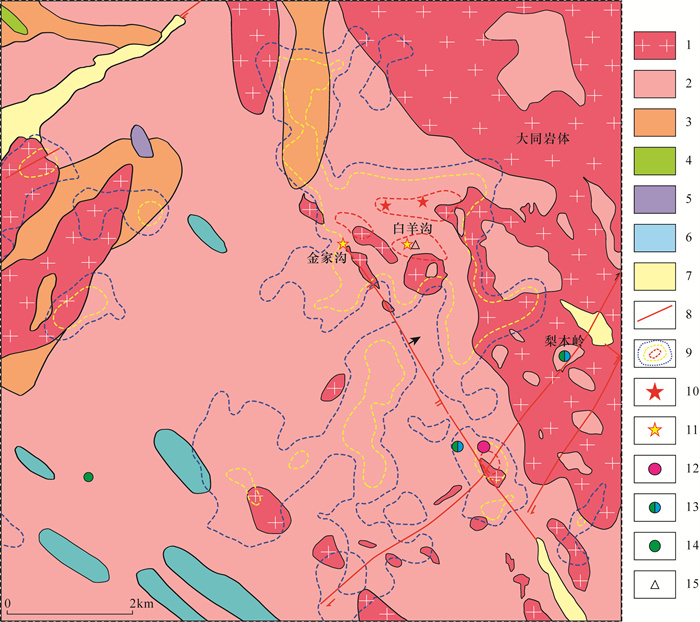
 下载:
下载:
